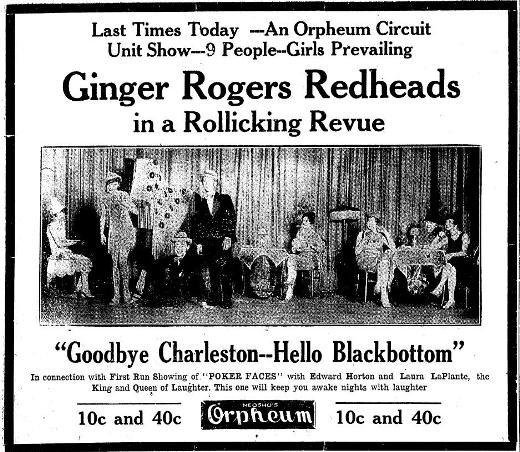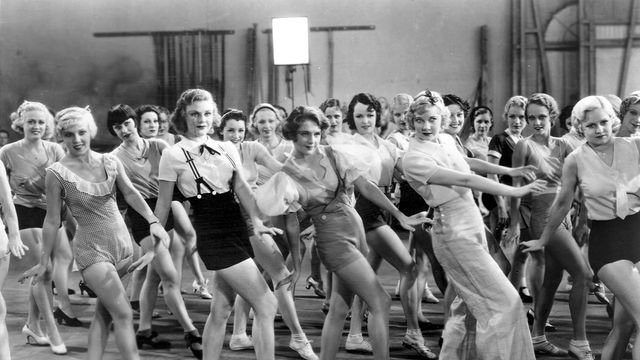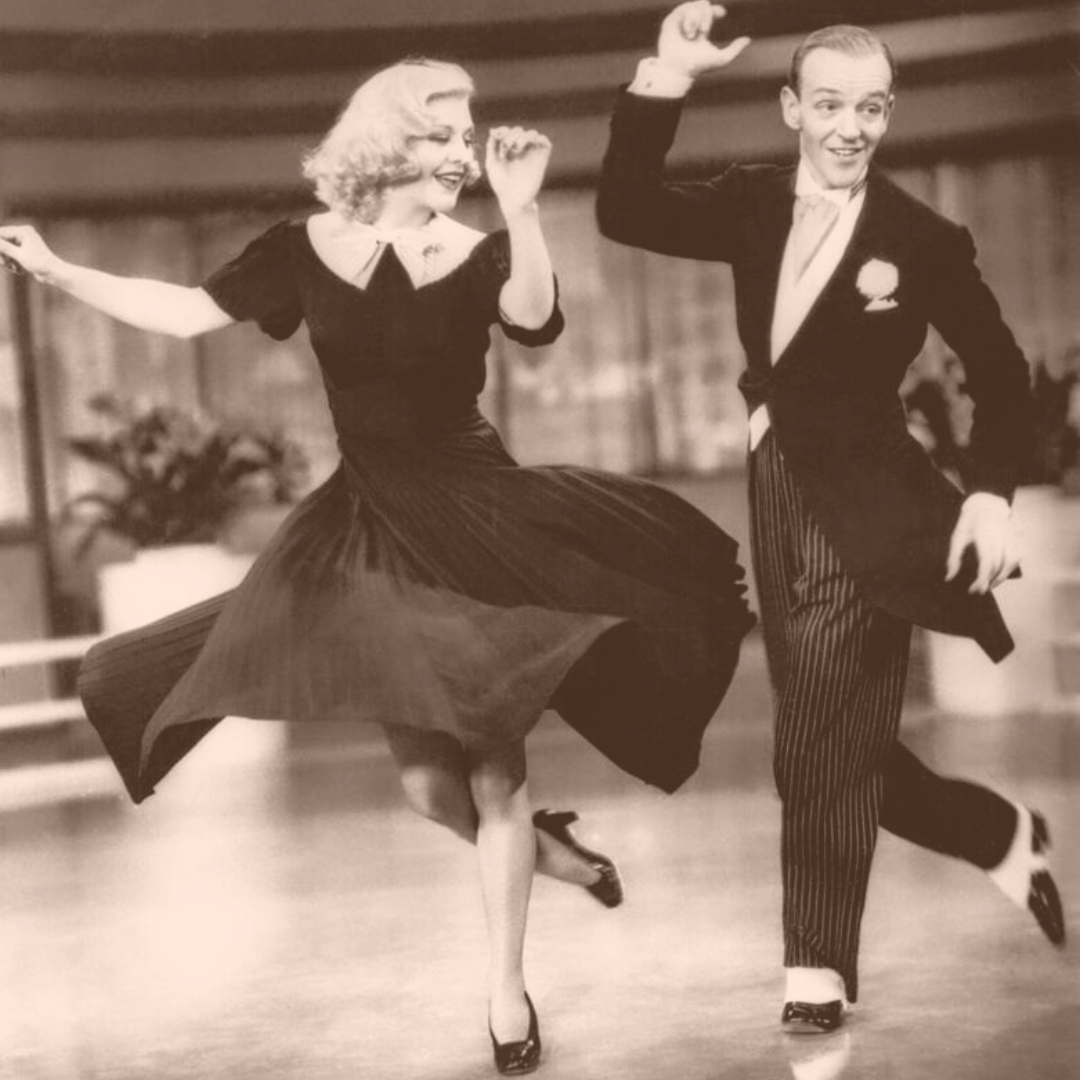Chorus Girl Herstory Ginger Rogers
Ginger Rogers (born Virginia Katherine McMath; July 16, 1911 – April 25, 1995) was an American actress, dancer and singer during the Golden Age of Hollywood. She won an Academy Award for Best Actress for her starring role in Kitty Foyle (1940), and performed during the 1930s in RKO's musical films with Fred Astaire. Her career continued on stage, radio and television throughout much of the 20th century.
Rogers was born in Independence, Missouri. Her parents separated shortly after she was born. After unsuccessfully trying to reunite with his family, McMath kidnapped his daughter twice, and her mother divorced him soon thereafter. Rogers said that she never saw her natural father again. In 1915, Rogers was left with her grandparents, who lived in nearby Kansas City, while her mother made a trip to Hollywood in an effort to get an essay she had written made into a film. She lived there with her grandparents until she was nine years old when her mother married John Logan Rogers. Ginger took the surname Rogers, although she was never legally adopted. She and her family moved to Fort Worth, Texas.
In 1925, she won a Charleston dance contest that helped her launch a successful vaudeville career. This allowed Ginger to tour as Ginger Rogers and the Redheads for six months on the Orpheum Circuit. After that, she gained recognition as a Broadway actress for her stage debut in Girl Crazy. This led to a contract with Paramount Pictures, which ended after five films. Rogers had her first successful film roles as a supporting actress in 42nd Street (1933) and Gold Diggers of 1933 (1933).
In the 1930s, Rogers's nine films with Fred Astaire are credited with revolutionizing the genre and gave RKO Pictures some of its biggest successes: The Gay Divorcee (1934), Top Hat (1935) and Swing Time (1936). But after two commercial failures with Astaire, she turned her focus to dramatic and comedy films. Her acting was well received by critics and audiences in films such as Stage Door (1937), Vivacious Lady (1938), Bachelor Mother (1939), Primrose Path (1940), The Major and the Minor (1942) and I'll Be Seeing You (1944). After winning the Oscar, Rogers became one of the biggest box-office draws and highest-paid actresses of the 1940s.
Rogers's popularity was peaking by the end of the decade. She reunited with Astaire in 1949 in the commercially successful The Barkleys of Broadway. She starred in the successful comedy Monkey Business (1952) and was critically lauded for her performance in Tight Spot (1955) before entering an unsuccessful period of filmmaking in the mid-1950s, and returned to Broadway in 1965, playing the lead role in Hello, Dolly! More Broadway roles followed, along with her stage directorial debut in 1985 of an off-Broadway production of Babes in Arms. She continued to act, making television appearances until 1987, and wrote an autobiography Ginger: My Story which was published in 1991. In 1992, Rogers was recognized at the Kennedy Center Honors. She died of natural causes in 1995, at age 83.
During her long career, Rogers made 73 films, and she ranks number 14 on the AFI's 100 Years...100 Stars list of female stars of classic American cinema.
Rogers, an only child, maintained a close relationship with her mother, Lela Rogers, throughout her life. Lela, a newspaper reporter, scriptwriter, and movie producer, was one of the first women to enlist in the Marine Corps, was a founder of the successful "Hollywood Playhouse" for aspiring actors and actresses on the RKO set, and a founder of the Motion Picture Alliance for the Preservation of American Ideals. She also wrote a children's mystery book with her daughter as the central character.
Ginger Rogers died at her Rancho Mirage home on April 25, 1995, after previously having lapsed into a diabetic coma, and then suffering a fatal stroke. She was 83. She was cremated and her ashes interred with her mother Lela Emogene in Oakwood Memorial Park Cemetery in Chatsworth, California.
The city of Independence, Missouri designated the birthplace of Ginger Rogers a Historic Landmark Property in 1994. On July 16, 1994, Ginger and her secretary, Roberta Olden, visited Independence, Missouri, to appear at the Ginger Rogers' Day celebration presented by the city. Rogers was present when Mayor Ron Stewart affixed a Historic Landmark Property plaque to the front of the house where she was born on July 16, 1911. She signed over 2,000 autographs at this event, which was one of her last public appearances.
The home was purchased in 2016 by Three Trails Cottages and restored, then transformed into a museum dedicated to Lela Owens-Rogers and Ginger Rogers. It contains memorabilia, magazines, movie posters, and many items from the ranch that Lela and Ginger owned. Several gowns that Ginger Rogers wore are on display. The museum was open seasonally from April to September, and several special events were held at the site each year. It closed in August 2019.
Rogers made her last public appearance on March 18, 1995, when she received the Women's International Center (WIC) Living Legacy Award. For many years, Rogers regularly supported, and held in-person presentations, at the Craterian Theater, in Medford, where she had performed in 1926 as a vaudevillian. The theater was comprehensively restored in 1997 and posthumously renamed in her honor as the Craterian Ginger Rogers Theater.
Sources:
Ginger Rogers A Bio-Bibliography by Jocelyn Faris
Backwards in High Heels: Examining the Careers and Artistic Contributions of Fred Astaire ’s Female Dance Partners by Fiona Mowbray
Rogers, Ginger (1911–1995) by John H. Slate
Ginger Rogers - The Kennedy Center Artist Collection
Ginger Rogers Collection at the University of Missouri Historic Costume and Textile Collection
Written by: Amanda Bernice




